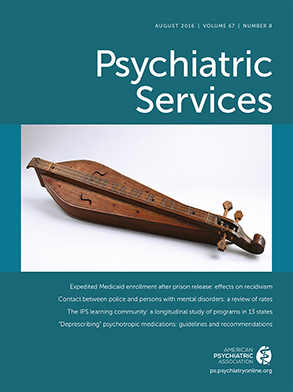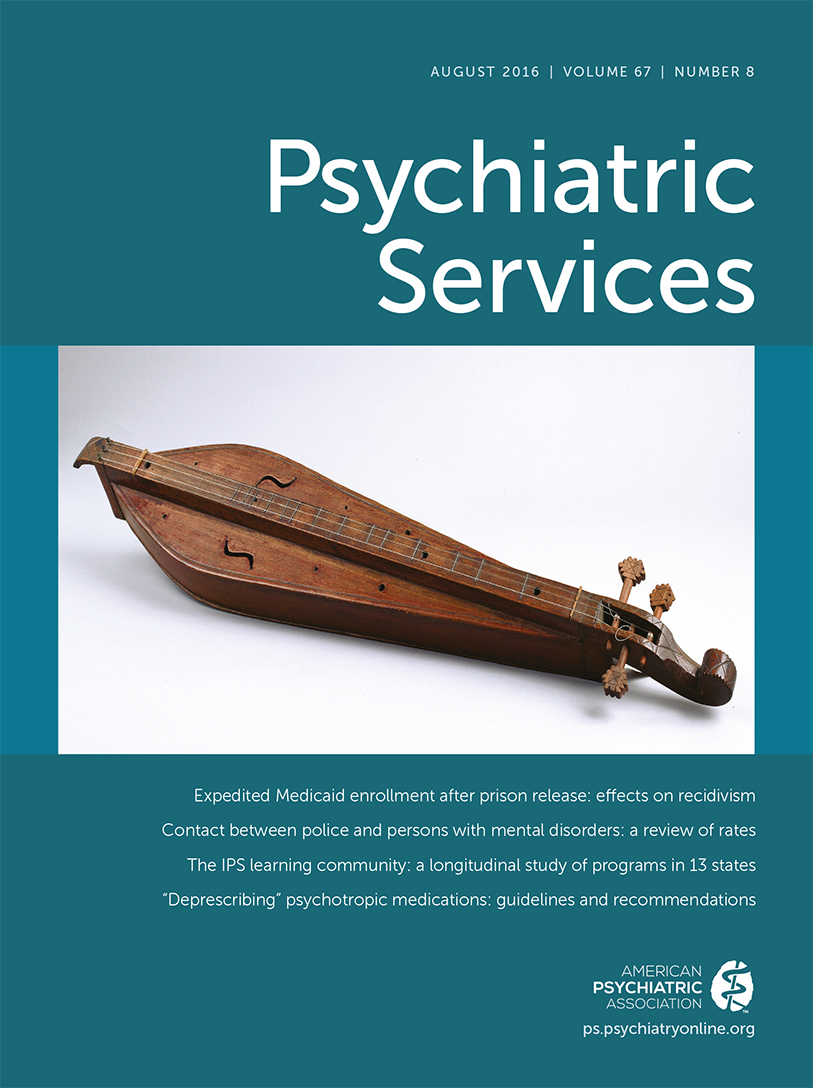Children subjected to abuse or neglect are the principal consumers of child mental health services in the United States today. Half of all maltreated children have clinically significant emotional or behavioral problems (
1), the costs of which are borne largely by Medicaid (
2).
It is known that maltreatment is associated with the development of emotional or behavioral problems among children (
1) and that Medicaid pays for treatment of those problems (
3). However, it is unknown if there is a threshold level of severity above which maltreatment triggers a psychiatric disorder, which then affects service use and expenditures among these children. Quantifying any such threshold effects of maltreatment severity upon service use can further our knowledge of the sequelae of maltreatment.
Prospective studies appear to provide evidence for the cumulative effects of maltreatment. Around 40% of children with one report of maltreatment had at least one adverse mental, general medical, or adverse social condition; this rate rose to 92% among children with 12 or more reports (
4). Experiencing one adverse exposure almost doubled the risk of overall poor health, and experiencing four or more adverse exposures nearly tripled the risk of general medical illness (
5).
In this study, we quantified psychotropic medication expenditures associated with three measures of maltreatment severity among children in the child welfare system. Measuring the cost of psychotropic medication is important because spending on psychotropic drugs accounts for approximately half of all spending for the treatment of emotional and behavioral disorders (
6) and because children in child welfare receive psychotropic medications at a rate that is two to three times higher than the rate among comparable children in the community (
7).
Methods
The National Survey of Child and Adolescent Well-Being I (NSCAW), was the first nationally representative, longitudinal study of children and adolescents who come into contact with child protection agencies for suspected maltreatment (
8). NSCAW data contain Social Security numbers (SSNs) of participants in 36 states, which we used to link 2,371 children in NSCAW to Medicaid records available from the Medicaid Analytic Extract, or MAX. The time frame of our study was 2000–2003, corresponding to the time frame of NSCAW administration. For NSCAW children without an SSN match, we used all unique combinations of five-digit ZIP code, date of birth, gender, and race-ethnicity to match children with their Medicaid record, for a total linked sample of 4,453 children.
We developed three specifications to quantify severity of maltreatment. First, assessments by the child’s welfare worker of physical abuse, sexual abuse, neglect, and abandonment were coded as binary variables. Our second operationalization was a cumulative model indicating the number of different types of abuse experienced by the child. Values ranged from 0, no maltreatment, to 4, all four types of maltreatment. Our third specification involved child welfare workers’ assessment of the level of harm caused by the abuse that led to the index report of maltreatment. For this variable, harm was categorized as none, mild, moderate, or severe.
Information about all other covariates, including child age, gender, and race-ethnicity, was provided by the child’s primary caregiver and was obtained from NSCAW. Children lived either at home with a permanent primary caregiver or out of home (family foster care or congregate care). Behavioral problems were indicated by a t score of ≥64 on the internalizing or externalizing scales of the Child Behavior Check List (CBCL) (
9). General medical health was defined as fair or poor versus excellent, very good, or good. Rural residence was used as a proxy for the supply of health care resources. We included dummy variables for insurance type from the Medicaid enrollment files and included year dummies to control for secular trends. All child-level covariates were measured at entry of the child into the NSCAW study.
The outcome variable was the sum of all psychotropic expenditures incurred per child for each calendar year of the study, according to claims from the child’s Medicaid drug (RX) file. This amount was adjusted to 2012 dollars.
Psychotropic medication expenditures for each of the three specifications were estimated by using a two-part model with psychotropic drug expenditures per child per year as the outcome. In the first part, we used logistic regression to estimate the annual probability of having any medication expenditures. In the second part, we used a generalized linear model (GLM) with a log link and a gamma distribution to estimate the effects of severity of maltreatment on medication expenditures. We developed predictive margins from the second part of our models to increase their interpretability; for example, the predictive margin of expenditures for children with severe maltreatment is the average difference between expenditures in dollars for severely maltreated children and for children without apparent maltreatment, after the model was adjusted to control for the other variables. All analyses were performed in Stata, version 13.1 (
10). This study was approved by the institutional review boards at our institutions.
Results
Of a total sample of 4,453 children, 2,157 (52%) were boys, and most were white (N=2,382, 53%) or African American (N=1,433, 32%), with smaller numbers of children of Hispanic, other, or mixed race-ethnicity. A total of 402 (9%) children were below age two. The majority of children (N=3,008, 70%) were determined by a child welfare worker to have been neglected. A total of 1,281 (29%) of children were physically abused, 568 (13%) were sexually abused, and 294 (6.6%) were abandoned. Around 250 (6%) children were not deemed to have incurred maltreatment. Most (N=3,336, 75%) children had experienced one type of maltreatment, 791 (18%) had experienced two types, 71 (2%) three types, and five (.1%) all four types of maltreatment. Irrespective of maltreatment determination, child welfare workers found no evidence of harm among 882 children (20%), mild harm among 1,143 (26%) children, moderate harm among 1,437 (32%) children, and severe harm among 991 (22%) children.
[A table summarizing the odds of a child’s incurring any psychotropic drug expenditures during a calendar year is available as an online supplement to this report.]
Table 1 presents predictive margins from the two-part model. Model 1 shows main effects of the four types of maltreatment and reveals that there was no statistically significant association between any of the abuse categories and expenditures for psychotropic medication. However, physically abused children had higher odds (odds ratio=1.34) and neglected children had lower odds (OR=.76) of incurring psychotropic drug expenditures (data not shown). Counts of different types of maltreatment (model 2) also were not associated with any significant increases in expenditures, nor was level of harm (model 3). Children who experienced the most severe level of harm had higher odds of medication use compared with children without appreciable harm (OR=1.33, data not shown).
Other covariates, however, were significantly associated with amount of expenditures. Male gender, increasing age, white race-ethnicity, out-of-home placement, and clinical scores for the externalizing and internalizing subscales of the CBCL all increased expenditures for these medications. Children with primary care case management insurance had lower expenditures for medications, conditional on use, compared with children in Medicaid fee-for-service insurance.
Discussion and Conclusions
The key finding of this study was that severity of maltreatment had no additional significant effect on drug expenditures after the analyses controlled for externalizing and internalizing child behaviors. One possible explanation for this finding is that decisions about the amount, type, and duration of use of psychotropic drugs are directed toward managing the sequelae of maltreatment, and not toward managing maltreatment per se. In other words, clinicians use medications in an attempt to alleviate the emotional, cognitive, and behavioral effects of abuse and neglect, grouped into disorders.
This possibility was reflected in the robust relationship between expenditures and CBCL scores, with CBCL scores mediating the relationship between maltreatment and drug expenditures. Children scoring in the clinical range of the CBCL’s externalizing subscale incurred about $465 more in expenditures for psychotropic drugs compared with children whose CBCL scores were below that cutpoint. A significant relationship existed between scoring in the clinical range of the CBCL’s internalizing subscale and higher psychotropic costs (about $150–$160 more on average). It appears that CBCL scores in this study were proxies for disorders that warrant treatment with psychotropic drugs.
However, effects for magnitude of maltreatment on the odds of psychotropic medication use were observed. Physically abused children had higher odds of psychotropic drug use compared with those without histories of physical abuse. The relationship between abuse type and odds of medication use has been the focus of prior studies (
7,
11), and our findings are generally consistent with those of other scholars.
All of these findings were subject to a few limitations. We did not observe children in managed care environments, the effects of which on drug expenditures cannot be estimated at a national level at the present time. Second, our data, while unique, were dated, which may limit generalizability to current medications and expenditures. Finally, maltreatment is underreported, and some forms of maltreatment (such as verbal abuse) were not captured in our data, and both were limitations that may downwardly bias our observed estimates.
Identifying and deploying better instruments to capture the psychological sequelae of child maltreatment will allow greater refinement of the costs to Medicaid agencies of child abuse and neglect nationwide.

